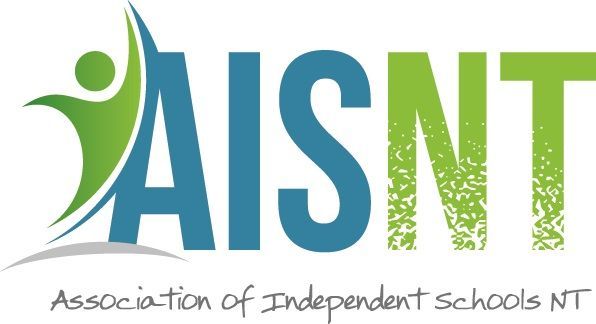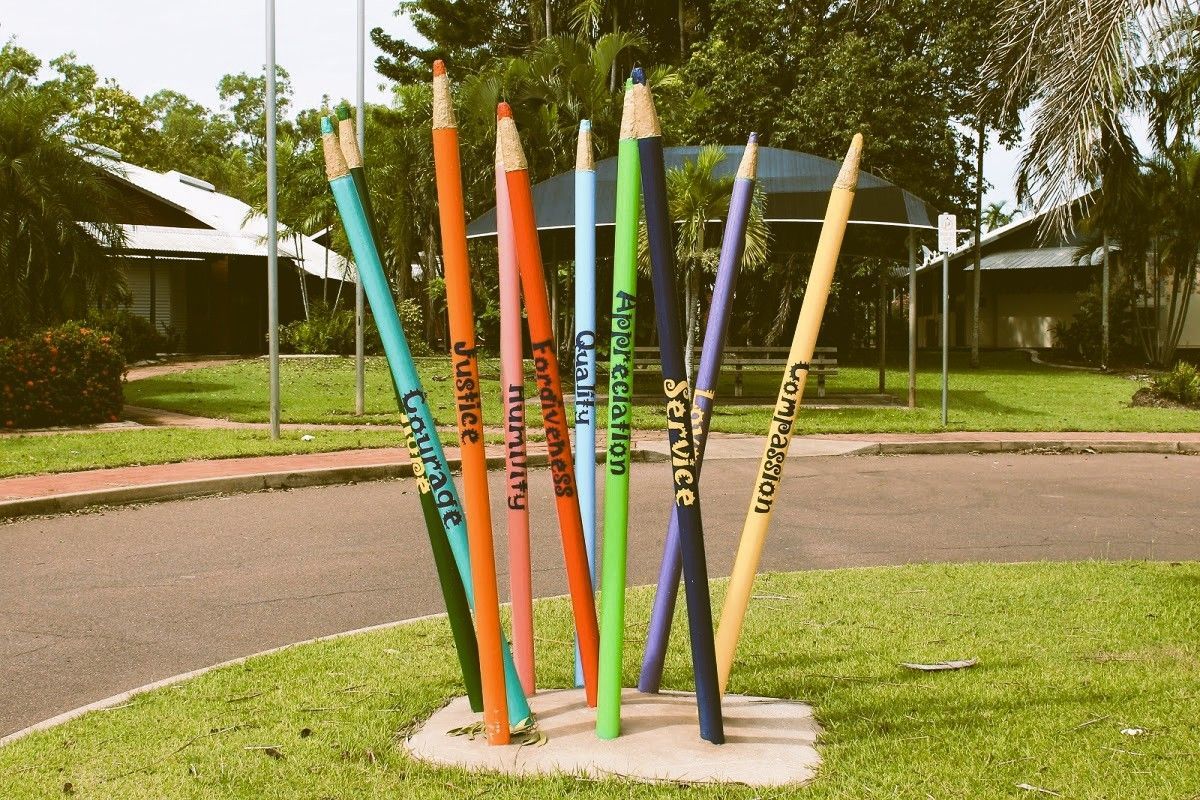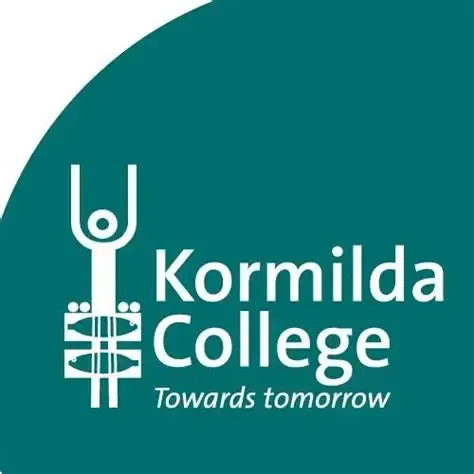History of Nyangatjatjara College
On Saturday August 9th 1997 Nyangatjatjara College opened its doors.
In 1995, September, Sandra Armstrong wrote the following which appeared on the front page of the program for the official opening and dedication of the college:
“Our office is talking about getting a school here, in the middle, to overcome this aching for home. We think this is good and right. As our children get bigger and older they have a school to go to. One that will be there for our children and our grandchildren’s children. We’re getting this growing. We were talking back in 1991 and now it’s happening, and we’re getting happy making this high school.”
Schools that arise to serve their communities often begin their journey with listening, not bending the message to suit another agenda but listening with a true purity of purpose. Such listening must cut through other cultural understandings if they are irrelevant, ignore bias and avoid the trap of slipping into what might have been done before, a state which often seems comfortable and less risky. For listening may lead to something which is entirely different and indeed untried.
And so it was that Nyangatjatjara College began its journey to produce a proposal for the Nyangatjatjara Aboriginal Corporation. Bill Davis was working amongst the Pitjinjarra people, as he had been for years, knew them, spoke their language and had their trust. He heard that education was important to the local people but they were keen that it should be two way. Children would be educated using their own language as well as English. Local customs and understandings would be taught and cultural mores respected. He and Laurie Gorman, who became Executive Officer of the Nyangatjatjara Corporation, were engaged to produce the Proposal to develop Nyangatjatjara College.
In September 1995, Charlie Walkabout, who was the Chairman of the Nyangatjatjara Aboriginal Corporation wrote the following:
“And we ask: “School! What for? Well it’s to learn English so it’s as good as what the White Fella speaks. The next wave of children should have English. Perhaps a Minister (of Government) might come, it’s no good someone like me, someone ignorant, or like my old father. No! We only know little bits of English. The kids must learn it fully so if the big Minister comes from Canberra he can be talked to properly. It's no good using (English) words you learn from drinking wine, all that yelling and swearing, you can’t use that - that wouldn’t be understood”.
The local people recognised that for such a school to be developed there was the need to engage the help of understanding white people who understood the complexity of “white fella” requirements, including funding, where to gain support and meet the various regulations.
Laurie Gorman wrote the following which also appeared in the program for the opening of the College.
“Establishing Nyangatjatjara College has been the most satisfying experience of my life.”
He also noted “that only by working simultaneously on all three fronts, that is by developing quality initiatives in Education, Enterprise and Employment, will there be a sustainable economic future for the people of this region.”
The vision of the school was clear in Charlie Walkabout’s mind in October 1995:
“So, we have these three main communities. We put the high school in the middle. Say the boys have come in first, after five weeks the girls come in, then the boys have another turn then the girls. Like that. This will prevent the girls becoming with child by strangers then to run away, that’s what happens otherwise. This way the parents are close and “wrong - way” relationships won’t develop. And that’s all I’ve got to say, my friends.”
Charlie’s anxieties are clear but the plan provided answers to these and a possible way forward.
The College was opened on 21July 1997. It started with one building and grew to multiple temporary buildings at four campuses based on the communities it served. The first Principal was Lillian Claire Howard. Her words appear in the Opening brochure:
“I am enjoying the opportunity to be involved in a creative process with the primary purpose of providing educational services to the young people of this region. It is a great opportunity for us to provide education which matches the needs and aspirations of the people. I have, like my Aṉangu counterparts, great expectations for this new school, which is today just a baby, but which will provide a comprehensive secondary education with a focus on vocational education for all young people in the central region. I look forward to working closely with Anangu to see their dreams become realities.”
Laurie’s work in bringing to fruition the plan for the College was thorough and convincing. All the various challenges were overcome and it was accepted by both the Federal and NT governments, resulting in their financial support.
Sadly Laurie Gorman tragically died at Angas Downs NT August 1998 whilst on a College trip. He was aged 47.
However the College continued to develop. After Lillian Howard, John Amadio, from South Australia, took the reins. He was experienced in Aboriginal education. In true pioneering style his accommodation was a caravan. It was obvious that the first buildings at Yulara were not sufficient and new ones needed to be built. John maintained a close relationship with AISNT recognising the importance of good networking in a young, remote, developing school.
A new Yulara campus was developed, architecturally designed and opened by the Hon Dr Brendan Nelson in 2005 while he was Federal Minister for Education, Science and Training. In 2002 the College had received a Commonwealth Grant of $2,480,000 for this project which was also during Dr Nelson’s time as minister. The buildings presented very well and the opening was a major event hosting many guests from elsewhere in the NT and interstate.
The College provides secondary education across three remote communities. All the students are Aṉangu and most are Pitjantjatjara first language speakers. The College is the only secondary education provider south of Alice Springs in the NT.
The four campuses of the College are Yulara, Kaltukatjara (Docker River), Imanpa, Mutitjulu.
Docker River is extremely remote. It’s estimated population is about 420. It is 230 km from Yulara and 670 km from Alice Springs.
Imanpa is a community 272km south of Alice Springs and 187 from Yulara. It has a population of about 220. the dominant language is is Pitjantjatjara. However, Arrernte, Luritja, Warlpiri and Yankunyjatjara are also spoken.
Mutitjulu is located 24 km from Yulara, has a population of about 350 and lies within the boundaries of the Uluru - Kata Tjuta National Park. The secondary students travel by bus everyday to the Colleges central campus in Yulara.
Ian White took over the reins in 2002 and remained until the end of 2003, when Bev Clarke took over.
Ralph Folds became Principal in 2006 He was a very experienced aboriginal educator and ran the College in 2006. It had fallen on difficult times and he left before the end of the year.
The Government conducted a review of the College and then asked Yirara College to take over the administration of it under the direction of Mark Doecke Yirarra’s Principal. Russell Erlandson was appointed Vice Principal but not CEO. He left before the end of 2007. Gail Donaldson was appointed to replace him.
In September 2008 management of the College was handed back to the local Board of Directors. However Yirara continued to be the service provider with Mark Doecke as Principal and Gail Donaldson as CEO. She left the position at the end of 2008 with Colin Baker replacing her.
Robyn Jorgensen was appointed CEO at the start of 2009.
In 2010 Mark Doecke left Central Australia to become CEO of Tiwi Collegate and was replaced by Brian Clancy in 2011.
Chris Harvey became Principal of Nyangatjatjara College in 2011and contributed a valuable term of 8 years, providing important stability and growth to the College which had seen several short term leadership appointments. During his time extensive improvements were undertaken including plans for the continued improvement of staff accommodation. The Docker River Primary School, which had previously been run by the NT Department of Education was acquired for the College. Aware that networking was vital for the Principal of a remote school Chris Harvey, during his time, was active in AISNT. He contributed greatly to the organisation serving time as the Association’s Chair and as a member of the National Board of Independent Schools Australia.
The next Principal was Mike Tucker who led the college for six years.The College was fortunate to have Mike Tucker as the next CEO of the Corporation and Principal of the College. Mike is a highly experienced educator with experience firstly in Queensland, then in Aboriginal Education in the remote Kimberley where he was Principal of Kulkarriya Community School. He is also the immediate past Chair of AISNT and served on the National Board of Independent Schools Australia.
The mission of the college was clearly outlined by Mike Tucker as follows:
“To educate these talented Aṉangu students to be confident young adults with foundation in a strong identity and willing participants in family and community. At the same time, these young people develop the skills and attributes to participate fully in the economy and the broader society.”
The College strives to maintain the high expectations of the Communities to see their children and grandchildren educated for a modern world with foundational knowledge of both worlds. This idea of two-way learning is the glue that binds these two worlds together. Looking backwards towards traditional knowledges and understandings at the same time as looking forward in the future based world of different thinking.
The College strives to send students out into the broader community as independent, strong Aṉangu adults who will be respectful models in their communities. This will be accomplished through their confidence, leadership and cultural understanding. They will be confident in their ability to operate with "a foot in both camps” with traditional Language and English and be able to share and articulate the appropriate aspects of Anangu culture and participate in the Australian economy through employment and enterprise. The image of our finished students is complete and balanced”.
The College sits within a broader Aboriginal Corporation under the Office of the Registrar of Indigenous Corporation (ORIC). The Principal holds the dual roles of CEO of the Corporation and Principal of the College a very challenging undertaking.
To run a complicated operation like Nyangatjatjara College requires someone with special skills. There aren’t many who have these and the appropriate experience, but Mike Tucker was one of these. He had a vision, understood how to work with indigenous people, was patient, hardworking and respected. He used initiative, coped sensibly in a crisis, and there are those, and knew how to create success.
At the conclusion of 2024 Mike Tucker retired from the position. His 6 years had provided important progress and stability. He had taken on the complexity of the Nyangatjatjara structure and worked tirelessly with it. Managing schools across many kilometers is a seemingly impossible task but Mike and the successful heads took the task front on. When staff were concerned about travelling the remote distances Mike set the example by doing it himself. Of course Chris Harvey was prepared to do the same. This gave the staff confidence which was necessary to enable the school to run. Both spent many hours on the road to support staff in the remote communities.
Also important for the success of this very remote school was the willingness and confidence to use initiative and to make wise but bold decisions. Requiring senior support staff person with diverse skills Chris Harvey took the wise opportunity to create new positions in leadership and employ staff who were experienced in their field and prepared to take initiative and act.
The people who have made lasting contributions to the college are the ones who are prepared to listen, reflect and act on what they have heard.
When looking at the history of Nyangatjatjara College it is worth noting the original understanding of Bill Davis who knew without a shadow of doubt that listening was paramount if a school was to be successful. Success for students can be achieved through relationship with the local people, by listening to them and by understanding them - not just thinking that understanding had been achieved when it hadn’t been but by genuine, empathetic, reflective, understanding.
Written by Chris Tudor,
AISNT Historian & Principal Liason



